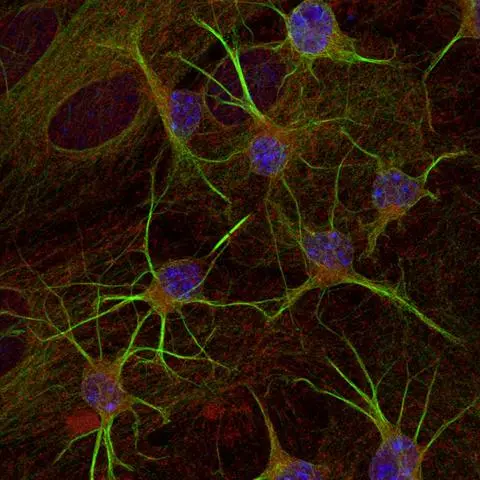GAD67 antibody
GTX101881
ApplicationsImmunoFluorescence, Western Blot, ImmunoCytoChemistry, ImmunoHistoChemistry, ImmunoHistoChemistry Frozen, ImmunoHistoChemistry Paraffin
Product group Antibodies
TargetGAD1
Overview
- SupplierGeneTex
- Product NameGAD67 antibody
- Delivery Days Customer9
- Application Supplier NoteWB: 1:500-1:3000. ICC/IF: 1:100-1:1000. IHC-P: 1:100-1:1000. IHC-Fr: 1:100-1:1000. *Optimal dilutions/concentrations should be determined by the researcher.Not tested in other applications.
- ApplicationsImmunoFluorescence, Western Blot, ImmunoCytoChemistry, ImmunoHistoChemistry, ImmunoHistoChemistry Frozen, ImmunoHistoChemistry Paraffin
- CertificationResearch Use Only
- ClonalityPolyclonal
- Concentration0.22 mg/ml
- ConjugateUnconjugated
- Gene ID2571
- Target nameGAD1
- Target descriptionglutamate decarboxylase 1
- Target synonyms67 kDa glutamic acid decarboxylase; CPSQ1; DEE89; GAD; GAD-67; glutamate decarboxylase 1; glutamate decarboxylase 1 (brain, 67kDa); SCP
- HostRabbit
- IsotypeIgG
- Protein IDQ99259
- Protein NameGlutamate decarboxylase 1
- Scientific DescriptionThis gene encodes one of several forms of glutamic acid decarboxylase, identified as a major autoantigen in insulin-dependent diabetes. The enzyme encoded is responsible for catalyzing the production of gamma-aminobutyric acid from L-glutamic acid. A pathogenic role for this enzyme has been identified in the human pancreas since it has been identified as an autoantigen and an autoreactive T cell target in insulin-dependent diabetes. This gene may also play a role in the stiff man syndrome. Deficiency in this enzyme has been shown to lead to pyridoxine dependency with seizures. Alternative splicing of this gene results in two products, the predominant 67-kD form and a less-frequent 25-kD form. [provided by RefSeq]
- Storage Instruction-20°C or -80°C,2°C to 8°C
- UNSPSC12352203
References
- Effects of the Co-Overexpression of the BCL and BDNF Genes on the Gamma-Aminobutyric Acid-Ergic Differentiation of Whartons-Jelly-Derived Mesenchymal Stem Cells.Read more
- Transcranial Ultrasound Stimulation Reverses Behavior Changes and the Expression of Calcium-Binding Protein in a Rodent Model of Schizophrenia.Read more
- ACE2 modulates glucose homeostasis through GABA signaling during metabolic stress. Ma X et al., 2020 Sep, J EndocrinolRead more
- Neural network disturbance in the medial prefrontal cortex might contribute to cognitive impairments induced by neuroinflammation. Ji MH et al., 2020 Oct, Brain Behav ImmunRead more
- Age-related Changes in Auditory Cortex Without Detectable Peripheral Alterations: A Multi-level Study in Sprague-Dawley Rats. Occelli F et al., 2019 Apr 15, NeuroscienceRead more
- Two Groups of eGFP-Expressing Neurons with Distinct Characteristics in the Neocortex of GIN Mice. Wang C et al., 2019 Apr 15, NeuroscienceRead more
- Loss of phenotype of parvalbumin interneurons in rat prefrontal cortex is involved in antidepressant- and propsychotic-like behaviors following acute and repeated ketamine administration. Zhou Z et al., 2015 Apr, Mol NeurobiolRead more




![ICC/IF analysis of A549 cells using GTX84469 GAD67 antibody [3G9].](https://www.genetex.com/upload/website/prouct_img/normal/GTX84469/GTX84469_1095_ICCIF_w_23061420_378.webp)
![ICC/IF analysis of COS7 cells transiently transfected with GAD67 plasmid using GTX84470 GAD67 antibody [3H2].](https://www.genetex.com/upload/website/prouct_img/normal/GTX84470/GTX84470_1096_ICCIF_w_23061420_241.webp)

